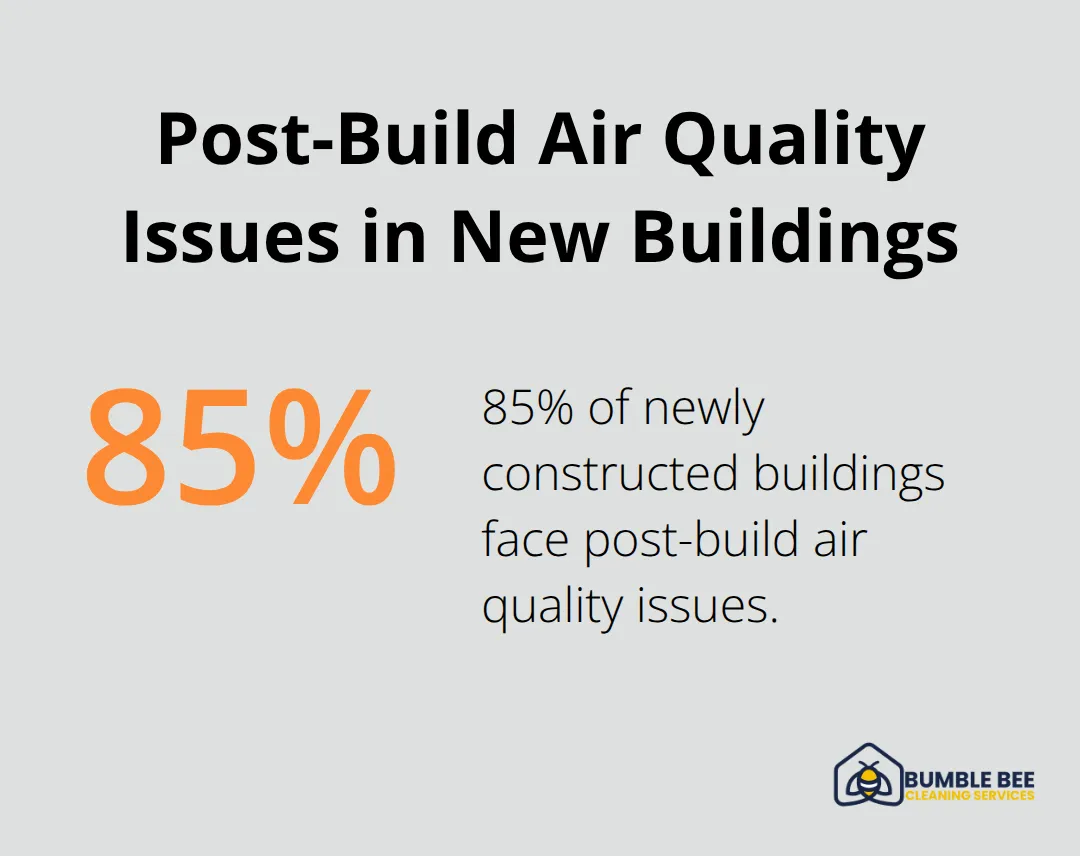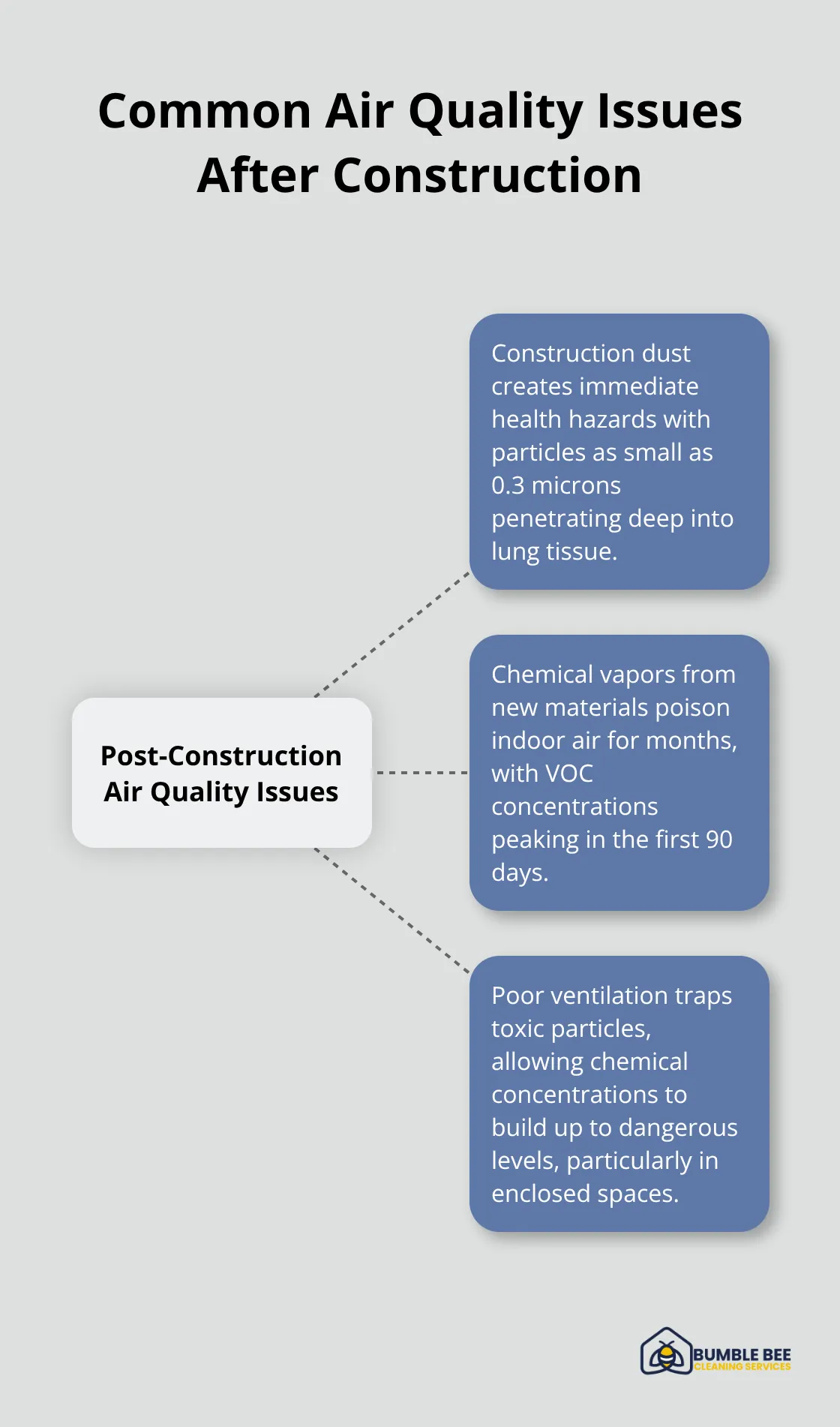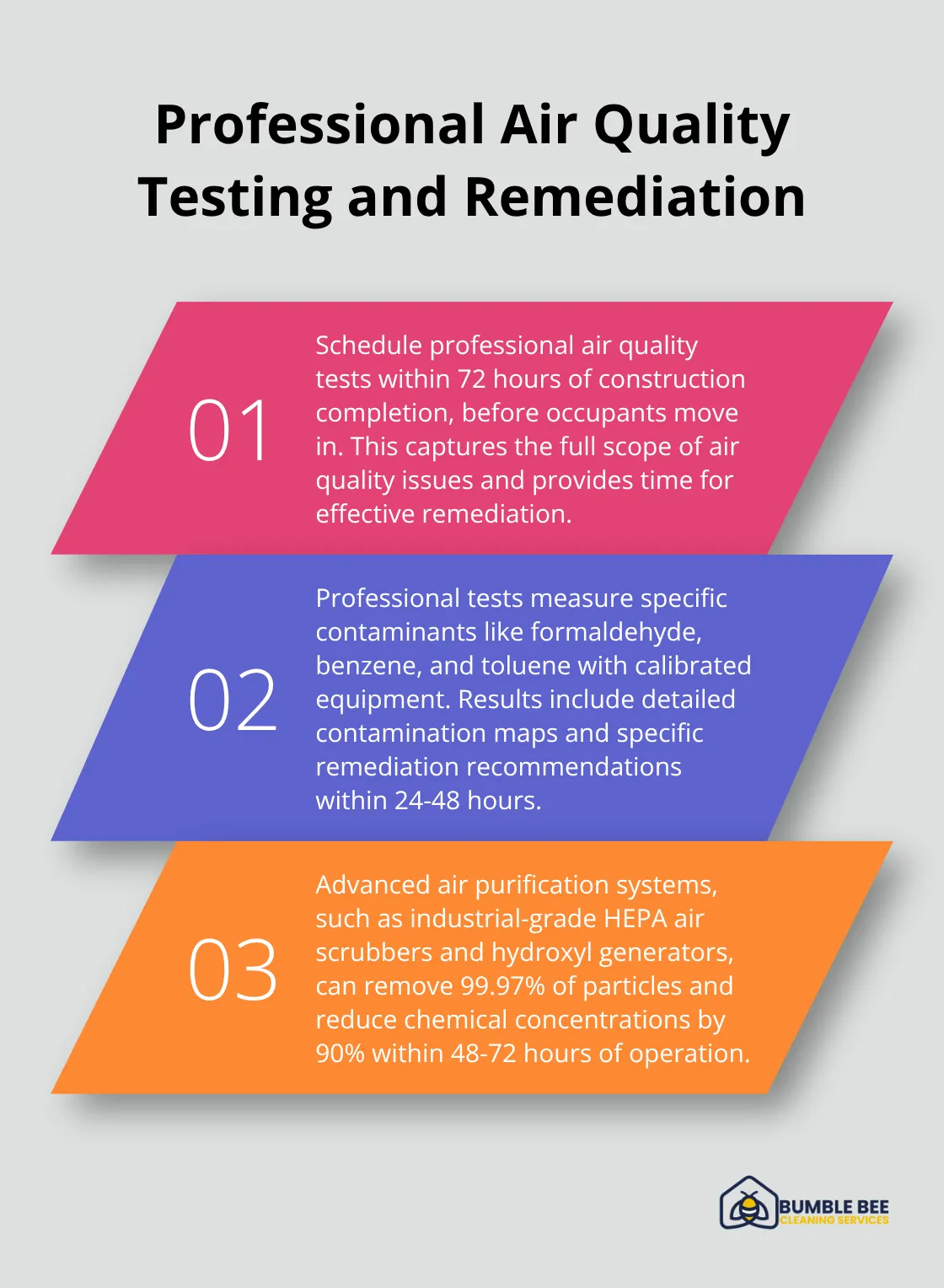Your Seattle construction project is complete, but the air inside might not be safe to breathe yet. Post-build air quality issues affect 85% of newly constructed buildings according to EPA data.

We at Bumble Bee Cleaning Services see firsthand how dust, chemicals, and poor ventilation create serious health risks for property owners and tenants.
The good news? Professional testing and remediation can protect your investment and your family’s wellbeing.
Health Risks from Poor Post-Construction Air Quality
Respiratory Issues Strike Immediately After Construction
Construction dust contains particles as small as 0.3 microns that penetrate deep into lung tissue and trigger immediate asthma attacks plus allergic reactions. OSHA identifies construction dust as a significant respiratory hazard, with fine particulate matter PM2.5 that causes inflammation within hours of exposure. Seattle residents face additional risks due to our humid climate, which allows dust particles to remain airborne longer than in drier regions. Children and elderly occupants experience the most severe reactions, which include persistent cough, throat irritation, and breathing difficulties that can last weeks after initial exposure.
Chemical Off-Gas from New Building Materials
New building materials release volatile organic compounds for months after installation, with formaldehyde levels in newly constructed homes creating significant indoor air exposure concerns. Paint, adhesives, and floor materials emit benzene, toluene, and xylene that cause headaches, dizziness, and eye irritation within 24-48 hours of exposure. The EPA reports that indoor air in new buildings can be 2-5 times more polluted than outdoor air due to chemical off-gas. Poor ventilation traps these toxins and creates a chemical mixture that affects cognitive function and sleep quality. Professional air quality tests reveal dangerous chemical concentrations that remain invisible to occupants until health symptoms appear.
Long-Term Health Damage Develops from Extended Exposure
Extended exposure to post-construction pollutants causes irreversible lung damage, chronic respiratory disease, and increased cancer risk according to recent medical studies. Workers and residents exposed to construction dust for extended periods show higher rates of lung function decline compared to those in clean environments. Heart disease risk increases in individuals who regularly breathe contaminated indoor air while neurological disorders develop more frequently in children exposed to construction chemicals during development years. These health impacts compound over time and create lasting damage that affects quality of life for decades.
The invisible nature of these air quality problems makes professional testing essential to identify specific contaminants that threaten your property.
Common Air Quality Issues After Construction

Construction Dust Creates Immediate Health Hazards
Construction debris produces three distinct particle sizes that affect your health differently. Coarse particles larger than 10 microns settle quickly on surfaces but become airborne again when you walk or move air around them. Fine particles between 2.5 and 10 microns enter your nasal passages and upper respiratory tract, where they cause immediate irritation and cough attacks. Ultrafine particles smaller than 2.5 microns bypass your body’s natural filters and enter your bloodstream through lung tissue.
Professional HEPA systems capture 99.97% of particles as small as 0.3 microns, while standard household vacuums miss these dangerous microscopic contaminants. Seattle’s high humidity levels cause dust particles to clump together and stick to surfaces, which makes removal significantly more difficult than in dry climates.
Chemical Vapors Poison Indoor Air for Months
New construction materials release volatile organic compounds into your indoor air, with concentrations that peak during the first 90 days after installation. Carpet adhesives emit 4-phenylcyclohexene, which causes eye and throat irritation at concentrations as low as 0.1 parts per million.
Fresh paint continues to release formaldehyde, benzene, and toluene for 6-8 months after application, with levels that often exceed EPA safety guidelines. Wood products and laminate floors off-gas formaldehyde at rates that double when temperatures exceed 75 degrees Fahrenheit. These chemical combinations create a toxic mixture that affects cognitive function, sleep quality, and respiratory health in ways that compound over time.
Poor Ventilation Traps Toxic Particles
Construction activities clog HVAC systems with debris and create air circulation problems that persist for months after project completion. Dust accumulation in ductwork reduces airflow efficiency while it spreads contaminated air throughout your property.
Plastic sheets and temporary barriers used during construction often remain in place and block natural ventilation pathways that normally refresh indoor air. Poor air circulation allows chemical concentrations to build up to dangerous levels, particularly in basements and enclosed spaces where heavier vapors settle and concentrate (creating invisible pockets of contamination).
Professional testing identifies these specific contaminants and measures their exact concentrations in your property.
Professional Air Quality Testing and Remediation

When to Schedule Air Quality Testing
Schedule professional air quality tests within 72 hours of construction completion, before any occupants move in or return to the space. The EPA recommends tests immediately after final cleanup but before furniture placement, when contaminant levels peak and remain easiest to measure accurately. Tests during this window capture the full scope of air quality issues while they provide time for effective remediation before occupancy. Seattle properties require additional test considerations due to high humidity levels that extend chemical off-gas periods and trap airborne particles longer than in drier climates.
What Professional Tests Include
Professional air quality assessments measure specific contaminants that standard home monitors miss completely. Certified technicians test for formaldehyde, benzene, toluene, and particulate matter with calibrated equipment that detects concentrations as low as 0.01 parts per million. Tests include surface samples for dust composition analysis, air samples for volatile organic compounds, and HVAC system inspections for contamination spread throughout your property. Results arrive within 24-48 hours and include detailed contamination maps that identify the worst-affected areas plus specific remediation recommendations. Professional tests cost between $300-800 for most Seattle properties but prevent thousands in potential health costs and property damage from undetected contamination.
Advanced Air Purification Systems
Industrial-grade HEPA air scrubbers remove 99.97% of particles while activated carbon filters absorb chemical vapors that standard home purifiers cannot capture. Professional remediation combines negative air pressure systems that prevent contamination spread with specialized techniques that target microscopic particles embedded in surfaces. Hydroxyl generators break down volatile organic compounds at the molecular level and reduce chemical concentrations by 90% within 48-72 hours of operation (making spaces safe for immediate occupancy). These advanced systems achieve indoor air quality levels that meet or exceed EPA safety standards for residential and commercial properties.
Final Thoughts
Post-build air quality tests protect your Seattle property investment and prevent costly health issues that develop from contaminated indoor environments. Professional remediation saves thousands in medical expenses while it maintains property values that drop when air quality problems persist unaddressed. Seattle property owners should schedule professional air quality tests within 72 hours of construction completion, followed by targeted remediation based on specific contamination findings.
We at Bumble Bee Cleaning Services combine ARCSI and IICRC certifications with specialized post-construction expertise that removes microscopic contaminants standard methods miss. Our comprehensive approach addresses dust particles, chemical residues, and HVAC contamination that threaten occupant health for months after construction completion. This proactive approach prevents respiratory damage, chemical exposure, and long-term health complications that affect families and tenants.
Professional post-construction services provide the specialized equipment and expertise needed to achieve EPA safety standards for indoor air quality (ensuring your space meets health requirements). Your investment deserves protection from invisible contaminants that compromise both health and property value. Post-build air contamination affects 85% of newly constructed buildings, making professional intervention essential for safe occupancy.
